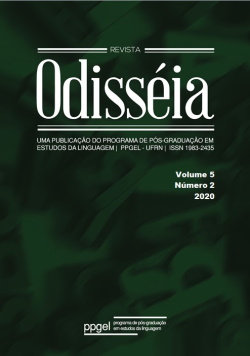Pornodyssey: translating rhythm, register and raunch
Pornodyssey: traduzindo ritmo, registro e rebuliço
DOI:
https://doi.org/10.21680/1983-2435.2020v5n2ID21318Palavras-chave:
Tradução Literária, Reinaldo Moraes, Pornopopéia, Literatura Brasileira ContemporâneaResumo
O romance celebrado, Pornopopéia, por Reinaldo Moraes, representa uma espécie de Ulysses joyceano do underground da cidade de São Paulo, nos excessos dos anos 80 estendidos até o início do século 21. Apesar da sua importância na literatura brasileira contemporânea e talvez por causa da sua complexidade linguística e literária na produção do humor distinta da obra, nunca foi traduzida para o inglês. Este artigo reporta em alguns resultados de uma pesquisa de estágio pós-doutoral, em que realizamos a tradução literária comentada dessa obra épica, Pornopopéia, traduzida como Pornodyssey. O arcabouço teórico-metodológico da pesquisa baseou-se de forma geral em um modelo de língua pela perspectiva da Teoria de Gênero e Registro (TGR) (MARTIN; ROSE, 2008) e no conceito da tradutologia de Berman (2012), enquanto a prática tradutória orientada nos conceitos adaptados de ‘total translation’ (tradução total) de Rothenberg (2010), a Teoria de Jazz de Frota (1998), ‘normas’ de Toury (1995), a discussão de Milton (1998) sobre metáforas para a prática tradutória. Alguns resultados apontam às seguintes características que contribuem ao humor e que apresentam desafios distintos na prática de traduzí-los: code-mixing e switching, trocadilhos, haiku, a velocidade de mudanças entre múltiplos registros desde eruditas aos de rua, a sonoridade, neologismos, blends e transgressões linguísticas, semânticas e genéricas, além das transgressões de cunho social. A partir dessas reflexões e das de tradução em si, esperamos oferecer para o leitor anglófono o prazer da leitura da obra de Reinaldo Moraes, ao mesmo tempo divulgar a literatura e a cultura brasileira para uma ampla comunidade de fala anglófona pela tradução, e por fim, contribuir com reflexões da prática tradutória para os estudos da tradução.
Downloads
Downloads
Publicado
Como Citar
Edição
Seção
Licença

Este trabalho foi licenciado com uma Licença http://creativecommons.org/licenses/by-nc-sa/4.0

















